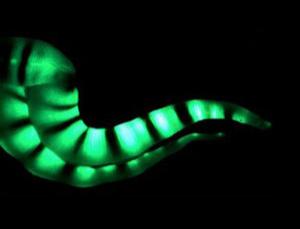
It was discovered by Jörg Wiedenmann of the National Oceanography Centre of the University of Southampton in the UK and his colleagues on an expedition to the floor of the Gulf of Mexico, 500 to 600 metres down.
The team hopes the discovery might turn out to be invaluable for biomedical studies, because of the unusual way that the fluorescence switches off under certain wavelengths of light. This could be exploited to reveal what's happening in the cells of living organisms in finer detail than is now possible.
Anemone hunt
Wiedenmann and his colleagues found the anemone when using a deep-diving research submarine equipped with cameras that can detect fluorescence. "A couple of animals showed fluorescence," he says. "There were some crustaceans that had a yellowish glow."
The team was hunting for either particularly bright animals or ones with unusual colours. "The most striking animals were these green fluorescent tube anemones."
The anemone may be a species that is new to science, as the researchers have not been able to identify it yet. While it is possible that the anemones use their fluorescence to attract prey, Wiedenmann points out that it might not have any evolutionary purpose.
"Haemoglobin makes red blood cells red, but their function is not to be red; their function is to carry oxygen," he notes. "An interesting question is whether there are animals around that can actually see the fluorescence."
Handy brightness
Fluorescent proteins have become essential to biomedical studies because when inserted into the cells of living creatures they can be used to study changes in the live organism, as they happen. This year, three researchers were awarded a Nobel Prize for discovering a widely used protein known as green fluorescent protein, or GFP (see a slideshow of how GFP has been used in research).
Wiedenmann and his colleagues have now isolated the protein that makes the anemones glow, which they have named cerFP505. It has one particularly unusual characteristic: it can be switched on and off by shining a light of a certain wavelength onto it.
When lit with light of wavelength 490 nanometres, a deep blue, it will switch on. But if ultraviolet light of a wavelength around 400 nm is shone onto it before it fluoresces, then it goes into an "off" mode, and cannot be switched on in the same way. Instead, only an intermediate wavelength between deep blue and ultra violet will work.
Biomedical researchers could use this ability to "switch off" cerFP505 to reveal far smaller structures in living cells than has previously been possible. When other fluorescent labels are used in living cells it is impossible to resolve very fine structures under a microscope because the fluorescent light generated by each part of the structure tends to bleed over a wider area, and merges into one.
But by applying labels to various parts of a structure, which can be switched on and off under different wavelengths of light, it could be possible to look at one area at a time. For example, you could measure two molecules that are just a few dozen nanometres apart, by switching on only one at a time.
See a gallery of glow-in-the-dark sea creatures here.
Journal reference: PLoS One (DOI: link)



Reader Comments
to our Newsletter